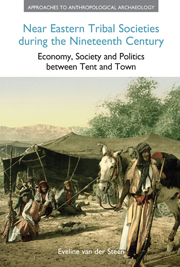 Near Eastern Tribal Societies during the Nineteenth Century
Near Eastern Tribal Societies during the Nineteenth Century The Queen of Hearts, she made some tarts,
All on a summer's day.
The Knave of Hearts, he stole those tarts,
And took them quite away!
(Lewis Carroll, Alice's Adventures in Wonderland, 1865)Introduction
During most of the nineteenth century the southern Levant and the Arabian Peninsula, although officially part of the Ottoman Empire, were virtually independent. The empire had interests in certain parts of it: the Hajj routes and the seaports. It made an effort to keep the main routes open and the ports profitable, but even that proved hard work at times. The region was controlled by tribes and more or less powerful local rulers. The relationship between them and the empire was mostly economic and political, and tribes, as well as towns, were treated as vassals or allies, rather than as subjects. The state used various tactics that were usually successful in manipulating the tribes, something they preferred to confrontational measures. In conflicts, particularly with the large tribes of the area, the empire did not always come out on top.
Nineteenth-century relationships between the government and the tribes
Areas of control
During most of the nineteenth century the Ottoman Empire had no control over the region south of Salt in Transjordan and south of Hebron in the west, or over most of the Arabian Peninsula. Salt was, in effect, an independent town (Burckhardt 1822: 265; Buckingham 1825: 27, 138; Oliphant 1880: 199). To the north of this area the government had some control, and the smaller tribes in the region north of Salt paid tax. The major tribes and many of the towns considered themselves independent of the government. Desert lands, from Syria in the north to the Arabian Peninsula in the south, were dominated by tribes of the powerful Anaze confederation: the Weld Ali in the north, the Rwala in the Syrian Desert, and the Bashir in the peninsula.
To save this book to your Kindle, first ensure [email protected] is added to your Approved Personal Document E-mail List under your Personal Document Settings on the Manage Your Content and Devices page of your Amazon account. Then enter the ‘name’ part of your Kindle email address below. Find out more about saving to your Kindle.
Note you can select to save to either the @free.kindle.com or @kindle.com variations. ‘@free.kindle.com’ emails are free but can only be saved to your device when it is connected to wi-fi. ‘@kindle.com’ emails can be delivered even when you are not connected to wi-fi, but note that service fees apply.
Find out more about the Kindle Personal Document Service.
To save content items to your account, please confirm that you agree to abide by our usage policies. If this is the first time you use this feature, you will be asked to authorise Cambridge Core to connect with your account. Find out more about saving content to Dropbox.
To save content items to your account, please confirm that you agree to abide by our usage policies. If this is the first time you use this feature, you will be asked to authorise Cambridge Core to connect with your account. Find out more about saving content to Google Drive.